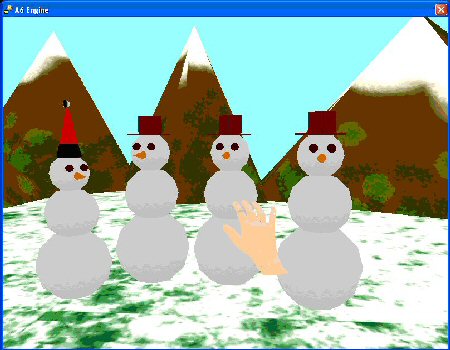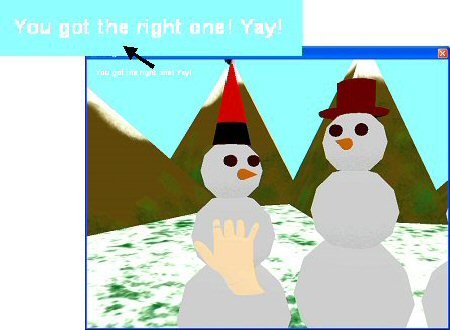Project Description: goals and purpose of the project
Cerebral Palsy (CP) is a neurological disorder that affects motor control. It is caused by an injury to the brain either before or during the birth of a child, or in the first months or years of a childs life. While there is no cure for CP, occupational therapy is often used to help improve the motor function of the effected limbs. The earlier a child begins such treatment, the better chance the child will have of overcoming the developmental disabilities caused by CP. Unfortunately, Occupational Therapy can be boring, frustrating, and painful for children. The use of a VR game that elicits the same motions as traditional therapy could have the potential to better motivate a child to participate in and enjoy therapy.
The goal of this project was to design and implement a Virtual Reality (VR) computer game which complements occupational therapy (OT) of children aged five to seven suffering from Cerebral Palsy (CP). The game was designed to encourage players to move their arms in motions similar to those desired by occupational therapists during traditional therapy. The intent was to combine the fun and excitement of a game with the benefits of OT.
Process used on the project
We began our project with background research in the areas of CP and VR for occupational and physical therapy. We then drafted a rough design and level progression for our game. After discussions about this design, we realized that more background research was necessary in the areas of childrens games, virtual reality, Cerebral Palsy, and occupational therapy. We purchased and investigated features of childrens games to determine what would be appealing to our target audience. We then refined our game design to meet our new specifications. Our next preparative step was to explore the program 3DGameStudio (3DGS) which we planned to use to implement our design. The interface of 3DGS was not intuitive and took us many hours of exploration and tutorials to become comfortable with. We used 3DGSs MED component to create the models and WED to design our levels for our game.
We initially planned to implement our "Christmas Tree" level. This level was planned to include a Christmas tree and ornaments that the player would reach for to hang on the tree. After meeting with professors from the Ithaca College Occupational Therapy Department, who are also therapists, we decided to implement our Snowman level first instead. The snowman level requires players to reach their hand out to touch and identify the odd snowman of the four presented to them. The reaching and holding motion of this level is similar to a basic therapy exercise that we all felt would most benefit our players.
In order to implement the Snowman level we had to create a series of similar but different snowmen models using MED. We used the bones modeling technique to animate a spinning snowman. We planned for this motion to display when the player touches the correct snowman. We used WED to design our level which takes place outdoors in a snowy, mountainous region. Image 1 is a screen shot of our level in WED as we were working on it.
Image 1
In order to incorporate the virtual reality aspects of our game, we planned for our players to interact with it using motion trackers. These trackers will be on their hands and moving their hand will move a hand model on the screen. A previous student had implemented this aspect into his senior project. We were able to use some of his files in our project. We learned a lot about how to implement our game by looking at his project documentation and code. Specifically, we learned to create models and program behaviors using scripting (in the 3DGS cscript language.)
Conclusions
Our design was well received by the Occupational Therapists, who thought that the different levels could be used to create the different types of motions used for therapy. For example, our Snowman level is a simple reach and touch, while the Christmas tree level requires moving the arm from one object to another. A level that involved steering a polar bear on a sled increases the amount of arm movement and the time the arm must be held up without rest.
Unfortunately, this initial game design was ambitious and written before we fully understood the creation process. Since neither of us had any previous experience using 3DGS, we spent a lot of time learning the program, which did not leave us enough time to implement the full game. We decided to implement one level the snowman level as a proof-of-concept and to provide an example for future development. This level has been completed and demonstrated.
The screen shots in Images 2 and 3 show how the game begins and what happens when the player selects the correct snowman (the graphical hand is controlled by the tracker worn by the user. ) 
Image 2
Image 3
Throughout this project we learned a lot about computer science and research in general. This was a useful introduction to the VR field, since neither of us have had the opportunity to study it previously. This may be useful in our future courses of study/research. We enjoyed exploring the game creation process and learning a new tool (3DGS). Although we had not used the scripting language cscript previously, we were able to use what we knew about C and C++ to implement it.
Websites Developed and Publications
Web pages developed:
none
Papers or posters at conferences:
- To be presented at the 2009 Ithaca College James J. Whalen Academic Symposium, 4/2009.
Back to 2007-2008 Project Listing